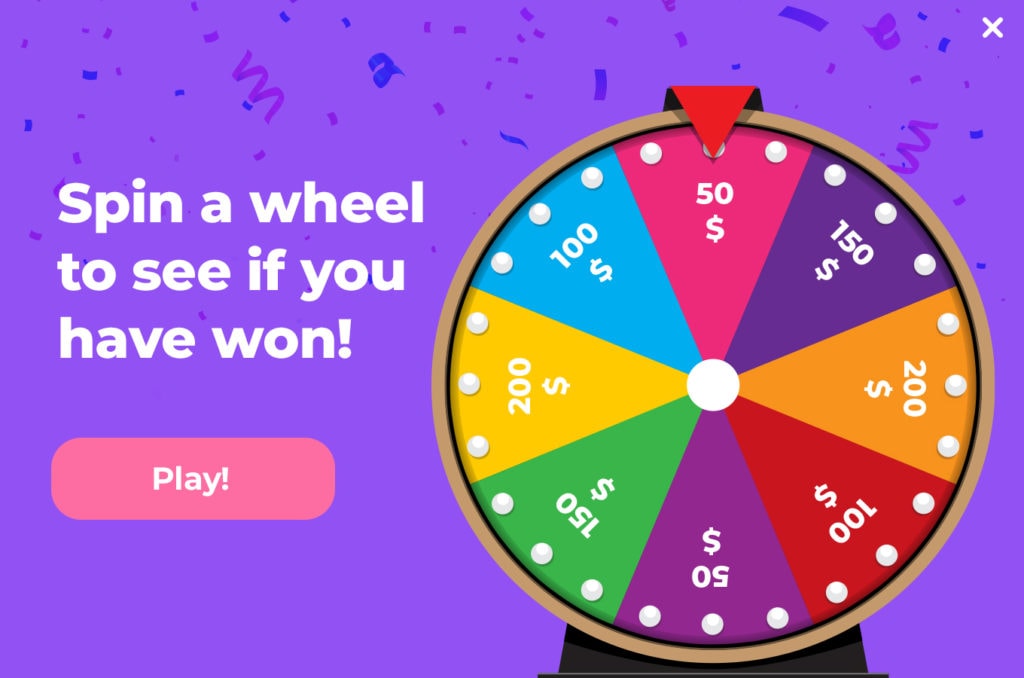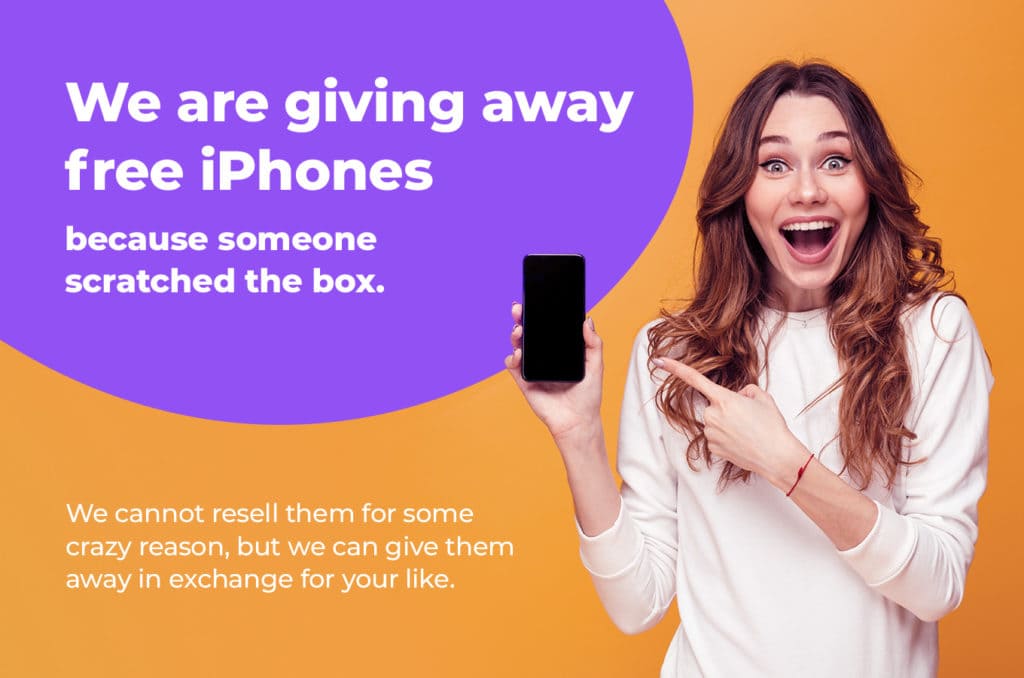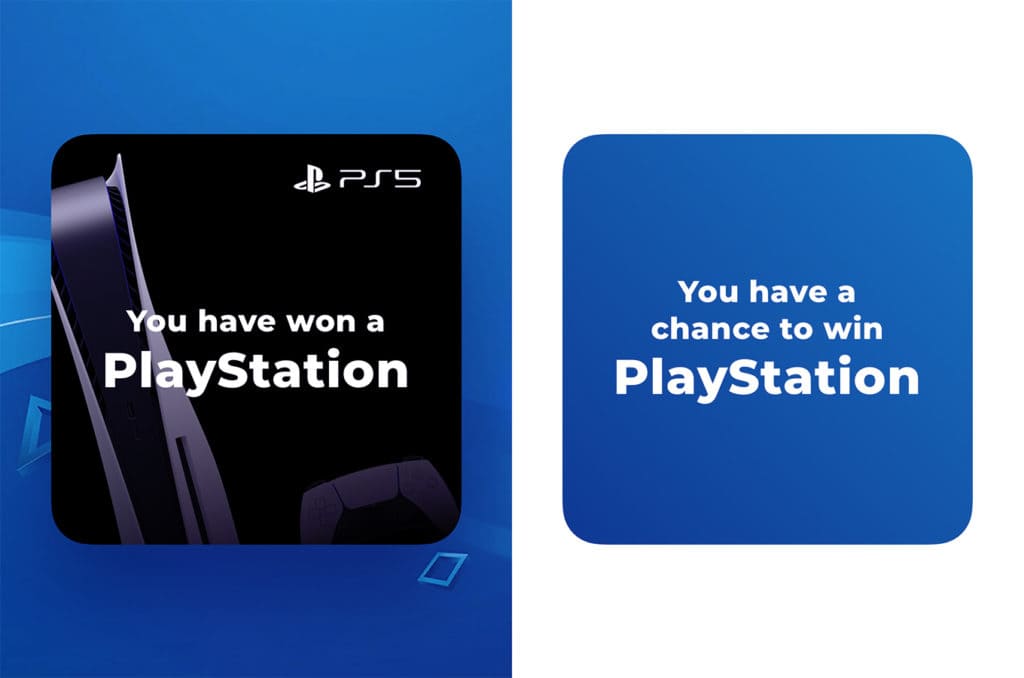If you have never felt a brief flutter in your chest when seeing a “You won an iPhone!” ad, then, well, welcome to the Internet. There are wonderful things ahead of you and many more sweepstakes offers like this one.
We have all been tricked at least once into believing that we’ve won an iPhone by simply visiting a web page. At first glance, we had no idea that this was an example of a sweepstake offer.
Sweepstakes are one of the most popular verticals in affiliate marketing. It is so popular that these types of offers are often synonymous with affiliate marketing.


But what are they really? What is the point of these alleged prizes? And are there any prizes at all?
So many questions! We’ll answer them all.
If you’re not familiar with any of the abbreviations used below – there’s a handy glossary at the end of this article!
What Are Sweepstakes?
Sweepstake, as the name suggests, is any offer type that resembles or promises a prize in a game of chance. Such offers may be:
- A game,

- A survey,

- A visit.

That last one gives you a little bit of nineties nostalgia, doesn’t it?
Of course, running a lottery is not the main point. The goal is to get something from a user: contact information and a credit card number, typically. So basically – lead generation. Sometimes a sweepstake offer is bundled in a deal called ‘coregistration’.
The bottom line is that a sweepstake is a hook, with a prize as a bait, and a user who is a very gullible fish.
What Types of Sweepstake Offers Are There?
We can distinguish three types of sweepstake offers:
Leadgen
The main goal of this type of offer is collecting leads. The more information you can gather the more valuable the lead is, but the bare minimum is of course an email address.
Apart from lead generation, you can ask about age, sex, city, and so on. Basically any information that advertisers deem valuable.
Leadgen sweepstakes typically use SOI or DOI flows (see the glossary below this article), with the first one usually bringing more conversions. This is a good moment to mention the rule of thumb in affiliate marketing:
“The easier it is to get an offer, the more people will do it”.
That’s why simple SOI leadgen sweepstakes offers are considered to be the best option and a gateway to sweepstakes affiliate marketing.
Mobile subscription
Mobile subscription offers aim to get a user to enroll in monthly paid subscriptions in exchange for, well, anything. Or nothing.
A daily text message with a joke of the day or a chance to win the new Xbox. No matter what’s promised, the goal is to charge users using DCB or CC on a monthly basis.
CC submit
Advertisers use all kinds of tricks, more and less legitimate, to get user’s credit card details. The more morally doubtful affiliate marketers tell a user that they need to submit their CC details to pay for a delivery of an alleged reward. Or to verify their identity in order to collect a reward…
Users are understandably not that eager to share their CC details. That’s why these offers usually have the highest payout but are considered to be the hardest to run.
How Does the Flow of Typical Sweepstakes Campaigns Look Like?
When a user clicks an advertisement of a sweepstakes affiliate offer, they are redirected to a landing page.
Very rarely do users go directly from landing pages to offer pages (direct linking). Why? Because they need to be warmed up, prepared, and above all, convinced why someone is willing to give them a reward.
This is something that is often glossed over when designing a campaign funnel.
People are precarious animals: they won’t do much without a reason or explanation, even if that explanation is not very good.
Take this for example:

I know, right?
But it is some kind of explanation. And people do not consider a like or their email address to be valuable and a high price for such a sweepstakes offer.
Many of them will fall for it, just for shits and giggles. And deep down many believe that it is that easy to make money online.
A landing page
A landing page gives credibility to the offer. You can provide users with a reason why this contest is being held. You can ask them about their preferred color of the iPhone they may win. You can provide users with a spinning wheel or a simple quiz to make them think it’s a real game.
Once they are ready, they go to the actual offer page where they can provide their contact information or credit card number.
Upon completion, a user will then be directed to the “Thank You” page. You can show additional offers there.
Are Sweepstake Offers Legit?
Sweepstakes offers are often associated with scamming blackhat practices. And there is a reason behind it. It may feel tempting to promise just about anything to make a user sign up for a subscription or share their email address.
Sweepstake offers aren’t inherently illegal. What’s not legal is:
- Promising something that you are not willing to deliver.
- Breaking sweepstake affiliate network or traffic source’s Terms and Conditions.
- Violating any other regulations, such as using brand logos without any permission.
This is often not a binary situation but a spectrum. Affiliates call it “aggressiveness” of landers. The more aggressive ones tend to over-promise or use brand colors or logos.
Aggressive landers:
- Tell you that you have actually won a Playstation.
- Use Sony’s logo and branding to make an offer look credible.
Clean landers:
- Use less definite language: “You have a chance to win a Playstation”.
- Use neutral colors or ones that are vaguely similar to brand colors and avoid using brand logos.

Sweepstakes affiliate networks and sweepstakes affiliate programs
Offer descriptions in affiliate networks often state if they allow aggressive landers or not. In case of doubt, or if you want to negotiate, you can always ask your AM if you can run more aggressive landers.
In many cases, if you are bringing them money, and/or you have a proven record of running successful campaigns, they may allow it or at least turn a blind eye.
If you decide to run aggressive campaigns without the sweepstakes affiliate networks consent, they may still allow it, or give you a warning, but they could also block your offer or even block your account and any money that you had there.
The reaction varies from network to network, and sometimes even from person to person.
Traffic Sources
In case of traffic sources you should follow their ToC. Some sources and some types of traffic are better fits for sweeps than others
More on the best types of traffic for sweeps in the question about traffic sources below.
Offer owner
The party that you should be most concerned about is actually the person that will pay an affiliate network in the end. If they catch you using too aggressive landers, then they won’t pay the network, and by implication, the network won’t pay you either.
Should I Choose a More Aggressive Approach?
We strongly encourage you to follow any regulations you should and a common ethic. There are advantages to going with a cleaner approach:
- You can get traffic from better placements.
- You can advertise on more traffic sources (see paragraph below).
An overall industry trend is to get advertising more civilized. This means that an era of dirty tricks is now gone.
However, this doesn’t mean that you cannot get close to the boundary without breaking any law. Careful wording and design that suggests, but not directly implies, can translate to higher conversion rates.
Try various approaches and see what works and what has been approved.
What Type of Traffic Works Best with Sweepstakes?
You can run sweepstake offers on various traffic types but some will be a better fit than others. Let’s go over the most popular ones:
- Google and Facebook: They are the most difficult ones to work with using this type of offer. They are focused more on protecting their users than on your success. You should run clean campaigns only and read their ToC’s in order to not get your account banned.
- Pop traffic. This works well with sweeps. Pops seem to be made with sweepstakes in mind: they are distinctive, alerting and sudden – these adjectives can easily describe sweeps as well.
- Push ads. Push traffic is great for sweeps, maybe even better than pops. The advantage over pops is that these ads do not appear in the context of a web page. This means an offer owner has basically a non-existent chance to see your ad. You can go a little bit more aggressive with push.
- Email. If you have a good database of email addresses that haven’t been spammed to death yet, email will work great with sweeps, especially with exclusive and direct offers.
Are Sweepstakes Hard to Master?
No. They do not require having any special knowledge to advertise. When advertising nutra offers for example, you should know something about dieting and health to write a convincing copy.
Sweeps only require you to know how to play on emotions and expectations and getting the right offers from top sweepstakes affiliate networks. It’s the essence of marketing.
Sweepstakes are therefore often recommended as a starting point for beginners. To be more precise, sweepstake leadgen offers, as CC submits are rather hard.

If you are concerned about building a website with interactive elements, such as a spinning wheel, you can always use existing elements for a small fee or rip landers using popular spying tools.
Should I Test My Offer Myself?
Yes, you should always follow the conversion flow and see how hard it is and if a conversion has been registered.
No, don’t count on getting an iPhone.
If you want to test, be sure to do this on a fresh computer that uses a different IP address, if possible. A common mistake: an advertiser tries to test an offer using their work computer and they get angry because even if they seemingly did everything required to get a conversion, it is not registered.
The common reasons include:
- Duplication. A conversion is often not registered for the second time from the same computer. It happens if you test and visit your offer several times without changing a computer.
- VPN. Many affiliate networks are good in detecting a VPN connection and they block conversions for such users. Don’t use a VPN network to test an offer but a separate computer, if possible.
- Fake credentials. If you try to test an offer using ‘Mickey Mouse’ as a username, you may find out that your affiliate network knows Disney and rejects all obviously fake leads.
Having all the above in mind, test an offer and see if you have set everything up correctly.
What are the Best Tips You Can Give Me on Running Sweepstakes?
#1
Sweepstakes work well with slightly older audiences. 16-year olds know the Internet well enough not to get fooled by such ads. Target people above 25 or 30. If you cannot target by age in your traffic source, create a lander where you ask about age and direct younger people to a different offer type.
#2
Don’t be so fixated on cloaking. Everyone says that you should cloak with sweeps. No, you do not. This is not essential, especially for newbies. Simply choose a high quality traffic source that is less restrictive than Facebook, for example.
#3
Last thing: don’t hesitate to talk with your AM. Ask what works, what kind of landers you can use on a given offer, what type of traffic works with it best. They want you to succeed – not because they are nice but because it is in their company’s best interest.
So, what are the prizes? Are they real?
They should be. Legally speaking, an offer owner should actually hand out rewards if they promise that they are going to. If that actually happens is above you.
Should I Track Sweepstakes?
Sweeps are no different from other offer types in this matter. Yes, you should track to learn what works, you should A/B test different approaches and optimize your sweepstake campaign.
The best companion for an affiliate marketer that runs sweeps is a good tracker and you cannot go wrong with Voluum – an industry-leader that gives you all the options you need plus some more for just a few dollars.
Get Voluum and safely dive into the world of sweepstakes now!
Glossary
CC submit – A conversion flow that requires providing a correct credit card number. A conversion is fired when the card is successfully charged.
DCB – Direct Carrier Billing. A type of billing in which a payment for an offer or subscription is made by adding it to a user’s phone bill. This type of billing is popular in Tier 3 countries, where regulations are not yet imposed and payment providers are not present.
DOI – Double Opt-In. A conversion flow that requires a two-step confirmation before firing a conversion. Typically, the first step is filling out a personal data survey and the second one is clicking on the confirmation link received in an email message.
Leadgen – A process of gathering user data (a.k.a. “leads”), such as email addresses or phone numbers. Leads are valuable for advertisers, as they allow them to send advertising messages directly to users.
MO – Mobile Originated. A conversion flow that requires sending a text message to an advertiser-specified phone number to confirm a conversion.
MT – Mobile Terminated. A conversion flow that requires submitting a mobile phone number, receiving a PIN number in a text message and submitting this PIN message on a web page.
SOI – Single Opt-In. A conversion flow that requires only one step confirmation. Typically, a user fills in a personal data survey and a conversion is fired when they click the ‘Ok’ or ‘Submit’ buttons. SOI are a characteristic of a not yet regulated market in a Tier 3 country.



